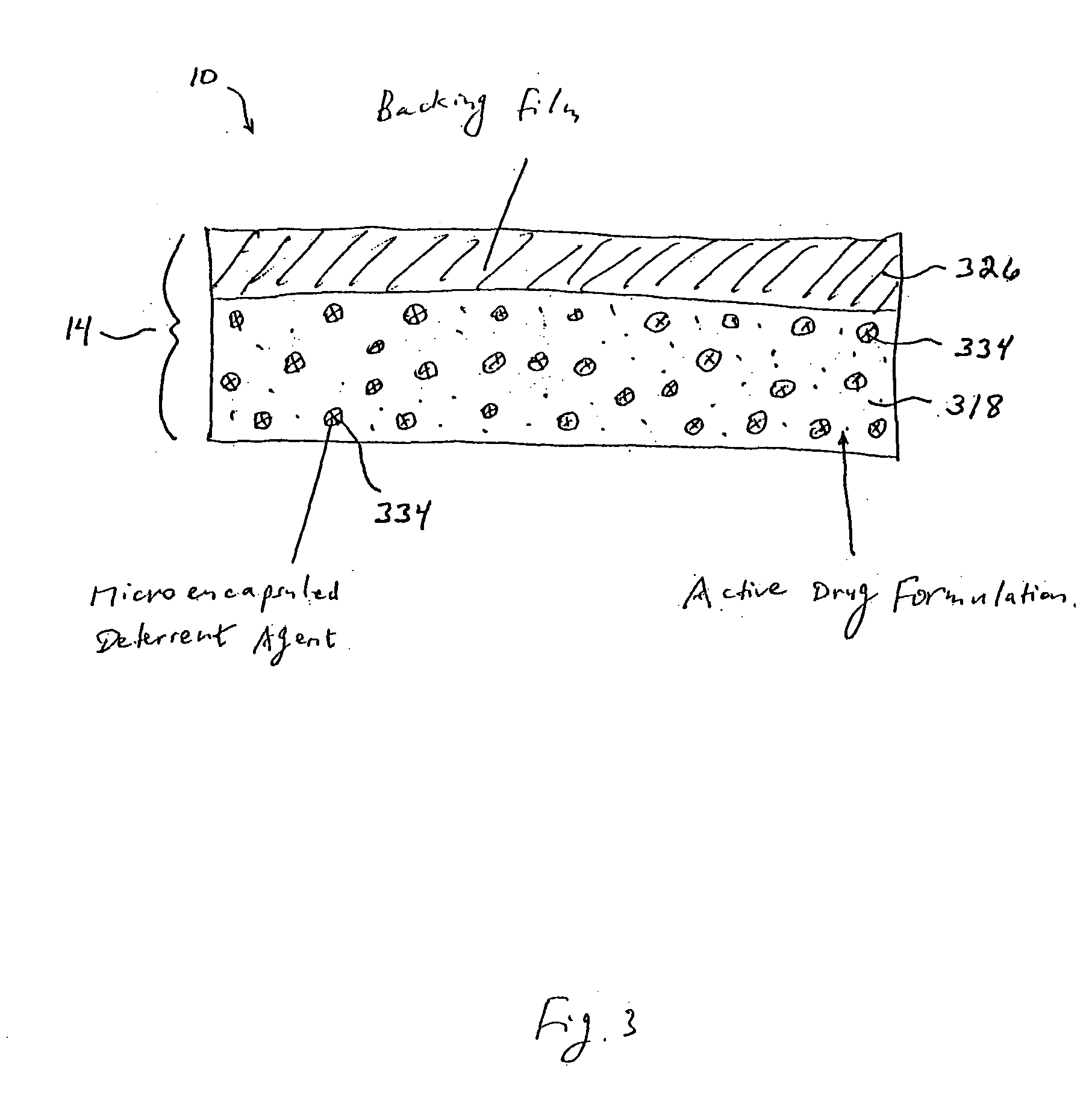[0008] Transdermal drug delivery systems provide an effective way to administer an active drug to a patient under a controlled environment. The present invention contemplates providing controlled active drug delivery of
narcotic agents through a transdermal delivery apparatus and method, while also providing for a reduced potential for abuse of the active drug.
[0009] In accordance with the invention as embodied and broadly described herein, the present invention features a transdermal drug
delivery system comprising (a) an active drug formulation contained within a carrier medium, wherein the active drug formulation comprises an abusable drug that may be systemically circulated within a user; (b) means for preventing the delivery of said deterrent agent into the user when the active drug formulation is systemically applied; and (c) a deterrent agent also contained within the carrier medium, and said deterrent is co-extracted with the active drug when the system is subject to an extraction solution or is co-administered with the active drug when the system is used on mucosal surfaces (i.e. oral transmucosal absorption or chewing in the mouth). In essence, the present invention describes a system and method for reducing the abuse potential of drugs, particularly or especially narcotic agents, in transdermal drug delivery systems. This is achieved by designing the transdermal drug delivery system such that when the active drug is extracted out of the transdermal delivery system, a deterrent agent is also timely co-extracted upon introduction of the system to an extraction solution where abuse may normally be allowed to take place. Preferably, the deterrent agent of the present invention is capable of inducing or causing one or more intensely unpleasant effects within the abusing person, thus minimizing the potential for abuse of the active drug formulation.
[0016] The present invention describes a method and system for reducing the abuse potential of drugs, and particularly or especially narcotic agents, in transdermal drug delivery systems. This is achieved by designing the transdermal delivery system such that when the active drug is extracted out of the transdermal delivery system, a deterrent agent is simultaneously co-extracted. Another design is that when the transdermal delivery system is used by the abuser in an unintended way to obtain a quicker absorption of the abusable drug, such as snorting or oral transmucosal delivery, the deterrent is co-administered with the abusable drug. Preferably, the deterrent agent of the present invention is capable of inducing or causing one or more intensely unpleasant effects, unrelated to the effects of the active drug itself, within the abusing person, thus reducing the potential for abuse of the active drug in the system. Stated differently, the deterrent agent existing within the transdermal drug delivery system functions to repulse the abuser by inducing violent and / or offensive bodily reactions, unrelated to the effects of the active drug itself, upon improper use of the transdermal drug delivery system. So severe are these reactions that the abuser is highly motivated thereafter to deliberately avoid such abuse in the future. Indeed, the presence of such a deterrent and associated repulsive effects serves to curtail any use of the drug beyond that which is appropriately prescribed, thus reducing the potential for abuse of the active drug. The severely unpleasant experience with the deterrent agent is worse than a mere minimized euphoria or at best a dissapointment of no euphoria that an antagonist can cause. Therefore, the inventor believes the abuse potential in the transdermal abusable drug delivery systems can be reduced more with the use of the deterrent, as provided in this invention, than systems that involves antagonist(s).
[0021] With reference to FIG. 3, shown is a third alternative embodiment of a transdermal drug delivery system 10 comprising an active drug formulation 318, a backing film 326, and a plurality of microencapsulated deterrent agents 334. In this design, deterrent agent 322 is microencapsulated with a material that is not soluble in the
solvent used in manufacturing the drug formulation, but is however, soluble in common solutions that may be used for extraction of active drug formulation 318. For example, acidic water or
alcohol may be used for extracting
fentanyl from a
silicone glue matrix formulation, and n-
heptane may be used as
solvent in manufacturing the
silicone formulation. As such, the microencapsulation material must be insoluble in n-
heptane and soluble in acidic water or
alcohol. When the transdermal drug delivery system 10 is placed into the extraction solution, the microcapsules dissolve and release the deterrent agent into the extraction solution, thus reducing the potential for abuse of the active drug formulation 218 existing within transdermal drug delivery system 10.
[0022] In a fourth embodiment, transdermal drug delivery system 10 is equipped with a deterrent agent that is extremely bitter to the taste, or that has another associated unpalatable taste, either in the formulation or coated in the back of the backing film. Many compounds can cause bitterness, including many alkaloids, such as
berberine and its derivatives (i.e.
berberine sulfate). The bitterness or the bad taste cannot be sensed by the
skin when the patch is used as intended. However, if the patch is placed in the mouth to obtain a quick delivery of the active drug through the oral mucosal absorption, the agent is released into the mouth via
saliva and causes an unpleasant bitterness or bad taste in the mouth, thus likewise reducing the potential for abuse.
 Login to View More
Login to View More  Login to View More
Login to View More 


